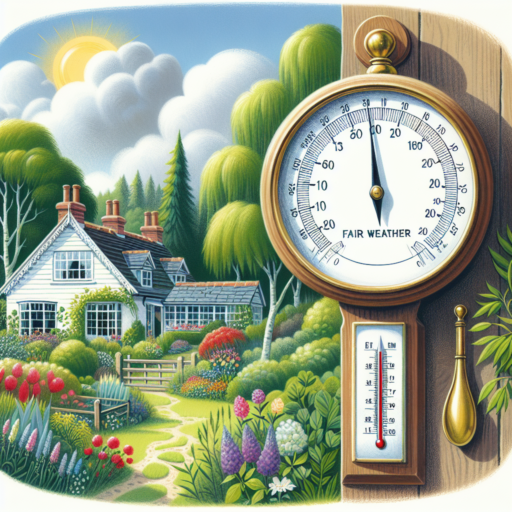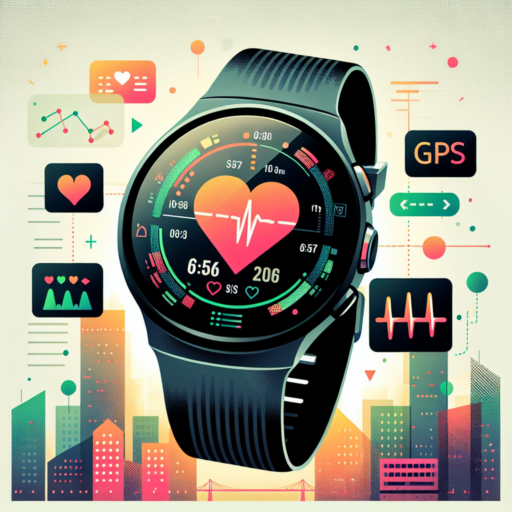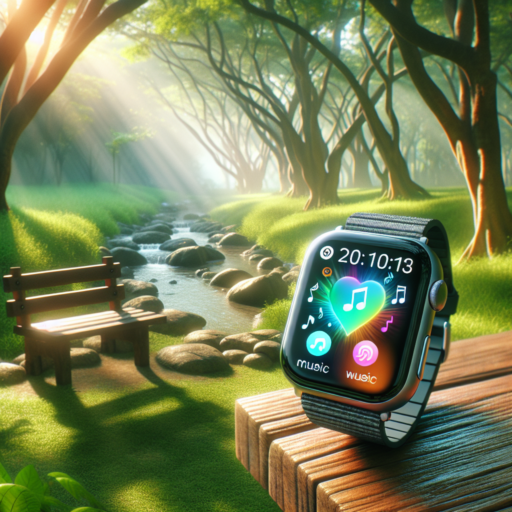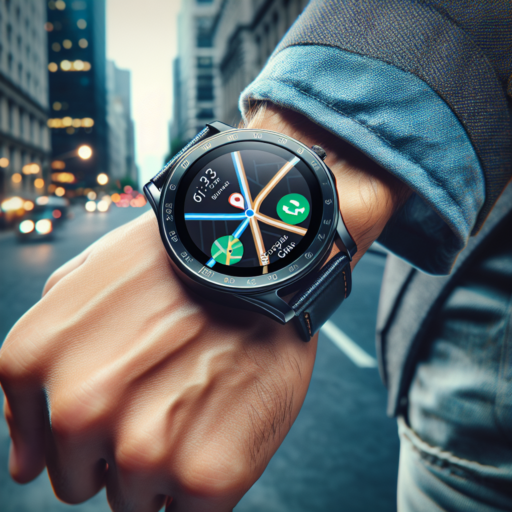Understanding the Importance of an Outdoor Barometer
An outdoor barometer goes beyond just being another tool in a weather enthusiast’s arsenal; it’s a vital instrument for anyone keen on understanding and preparing for changes in atmospheric pressure. These changes directly impact the weather conditions, making a barometer an indispensable tool for predicting short-term weather patterns. By closely monitoring the barometer’s readings, individuals can make informed decisions about their outdoor activities, ensuring safety and comfort.
Tracking Storm Patterns is one of the key uses of an outdoor barometer. A falling barometer reading typically indicates that a storm is approaching, giving individuals ample time to prepare or seek shelter. Conversely, a rising barometer suggests improving weather conditions, signaling a potential clear-out. This simple yet effective monitoring can be crucial for outdoor enthusiasts, mariners, or anyone planning significant outdoor events.
How a Barometer Adds Value to Daily Life
Moreover, integrating barometric readings into daily life can assist in planning activities, from gardening to hiking, by understanding the best times to undertake these tasks. Barometers, especially those designed for outdoor use, are built to withstand environmental elements, providing reliable information regardless of the conditions. Hence, they offer not just a measure of atmospheric pressure but a guide to navigating the day-to-day decisions influenced by weather changes.
Top Features to Look For in an Outdoor Barometer
When choosing the perfect outdoor barometer, it’s essential to focus on features that not only enhance functionality but also ensure reliability in varied outdoor conditions. From the construction material to the precision of readings, each feature plays a crucial role in making an outdoor barometer a valuable instrument for weather prediction and outdoor planning.
Durability and Weather Resistance
One of the primary features to look for in an outdoor barometer is its durability and weather resistance. Given that it will be used in various environmental conditions, the device should be capable of withstanding extreme temperatures, humidity, and water exposure. Ideally, a robust construction with waterproof or water-resistant capabilities will significantly extend the lifespan and performance of the barometer in challenging outdoor settings.
Precision and Calibration Options
Accuracy is non-negotiable when it comes to measuring atmospheric pressure. A top-quality outdoor barometer should offer high precision readings with the ability to be easily calibrated for local conditions. This feature ensures that you can rely on your device for accurate weather predictions, which is especially crucial for planning outdoor activities or for professional meteorological uses. Look for models that provide detailed instructions or features for simple calibration processes.
Readability and Display Features
No matter how advanced a barometer is, its effectiveness is limited if you can’t easily read the measurements. Opt for an outdoor barometer with a clear and easy-to-read display. Backlit screens or large, bold numbers can make a significant difference in visibility, especially in low-light conditions or when quickly glancing at the device during outdoor adventures. Additionally, a user-friendly interface that allows you to toggle between units of measurement and view historical data can enhance your experience and provide valuable insights into weather trends.
How to Use an Outdoor Barometer for Weather Prediction
Understanding how to use an outdoor barometer for weather prediction can enhance your outdoor experiences and even safeguard your plans from unexpected weather changes. Barometers measure atmospheric pressure, and variations in this pressure can provide valuable insights into upcoming weather conditions. By keeping an eye on these changes, you can predict local weather patterns with impressive accuracy.
Firstly, it’s essential to monitor the barometer readings regularly to notice the patterns of atmospheric pressure changes. A rising barometer indicates improving weather conditions, while a falling barometer suggests deteriorating weather, potentially signaling the approach of a storm or rainfall. It’s the speed of this change that offers the most valuable forecast information; rapid drops in atmospheric pressure often precede more drastic weather changes.
To further refine your weather predictions, consider maintaining a log of barometer readings. This practice can help you notice more subtle patterns over time, improving your forecasting skills. Additionally, comparing your observations with local weather reports can validate your predictions and enhance your understanding of how atmospheric pressure influences the weather in your area.
The Best Outdoor Barometers for Hiking and Camping
When selecting the best outdoor barometers for hiking and camping, it’s crucial to consider durability, accuracy, and ease of use. These devices can be vital tools for predicting weather changes and ensuring safety during outdoor adventures. A high-quality barometer will alert you to impending changes in weather, giving you time to seek shelter or adjust your plans accordingly.
Features to Look for in a Quality Outdoor Barometer
- Durability: Look for barometers made with rugged, weather-resistant materials suitable for the outdoors.
- Accuracy: Precision is key when it comes to weather prediction. Opt for models known for their reliability and accuracy.
- Portability: Since weight and space are precious when hiking or camping, a compact and lightweight design is essential.
Modern advancements have also introduced features like digital displays, altimeter functions, and connectivity with smartphones, enhancing the functionality and convenience of outdoor barometers. Whether you’re planning a day hike or a multi-day backcountry excursion, having a reliable barometer can make a significant difference in your preparedness for whatever weather comes your way.
Comparison of Digital vs. Analog Outdoor Barometers
When exploring the world of outdoor barometers, the debate between digital and analog devices often emerges as a topic of interest. Each type of barometer offers unique features and benefits tailored to different preferences and needs. Understanding the core differences can help enthusiasts and professionals alike make more informed decisions when selecting their atmospheric pressure measuring tools.
Accuracy and Precision
Digital barometers are renowned for their precision and accuracy. Thanks to advanced technology, they can provide readings down to the nearest tenth of a millibar. This precision is crucial for professionals in meteorology and individuals who rely on exact atmospheric readings for activities like sailing or hiking. Analog barometers, while less precise in their measurements, offer a visual appeal and a traditional touch that many users appreciate. Their functionality is rooted in a more hands-on approach, which can enhance the experience for users who prefer a tactile interaction with their instruments.
Ease of Reading and Usability
One of the distinct advantages of digital barometers is their ease of reading. With digital displays, readings can be seen at a glance, often illuminated for clear visibility in all light conditions. This contrasts with analog barometers, which require interpretation of the needle’s position against a scale. While this may present a learning curve for some, it provides a depth of engagement that digital screens cannot match. Furthermore, digital models frequently come with additional features such as temperature and humidity readings, all accessible through simple user interfaces.
No se han encontrado productos.
Maintenance Tips for Your Outdoor Barometer
Maintaining your outdoor barometer is essential for ensuring its accuracy and longevity. These precise instruments can be affected by various external factors, and without proper care, their performance may decline. Here, we share some vital tips to help preserve your barometer’s condition and ensure it continues to provide you with reliable weather predictions.
Regular Cleaning
One of the most basic yet crucial steps in maintaining your outdoor barometer is regular cleaning. Dust, dirt, and other airborne particles can accumulate on your barometer, potentially affecting its sensitivity and accuracy. To clean your barometer, gently wipe the exterior with a soft, dry cloth. Avoid using cleaning agents or water directly on the device, as moisture can damage its mechanism. If your barometer has a glass cover, you can use a glass cleaner, but apply it to the cloth first rather than spraying it directly onto the glass.
Protecting from Extreme Weather Conditions
While outdoor barometers are designed to withstand the elements, extreme weather conditions can still pose a threat. Excessive exposure to sunlight can cause the materials to degrade, while too much moisture can lead to corrosion or fungal growth. To protect your barometer, place it in a location that gets shade for part of the day and has some shelter from direct rain or snow. A covered porch or a north-facing wall can be ideal choices.
Regular monitoring and minor adjustments are also part of maintaining an outdoor barometer. Changes in altitude or shifts in weather patterns may require recalibration to maintain accuracy. Refer to your manufacturer’s guidelines for specific instructions on adjusting your barometer. Remember, a well-maintained barometer not only performs better but also serves as a fascinating decorative piece that adds a touch of elegance to your outdoor space.
Reading Your Outdoor Barometer: A Beginner’s Guide
Understanding the basics of reading your outdoor barometer can be quite straightforward once you get to know the tool and what its measurements mean for the weather. Essentially, a barometer measures atmospheric pressure, providing insights into whether you can expect clear skies, storms, or changes in weather patterns. This beginner’s guide aims to demystify the process, making it easier for anyone to use this useful forecasting tool.
Identifying Your Barometer Type
Firstly, it’s important to recognize the type of barometer you have. The two main types are aneroid and mercury barometers. Aneroid barometers, which are more common for personal use, utilize a small, sealed metal chamber that expands and contracts with atmospheric pressure changes. Mercury barometers, on the other hand, measure air pressure using mercury in a glass tube. Knowing which type you have is crucial for accurate reading and interpretation.
How to Read a Barometer
For aneroid barometer owners, reading the device involves noting the position of the needle against a printed scale, usually marked in inches of mercury (inHg) or millibars. A rising needle indicates increasing air pressure, suggesting improving weather conditions, while a falling needle points to decreasing pressure and a likelihood of bad weather. Mercury barometer readings involve observing the level of mercury in the glass tube; the higher the mercury rises, the greater the air pressure and vice versa.
Remember, the absolute value is less important than noticing changes over time. A steady increase or decrease in pressure can provide valuable forecasts. Sudden, sharp changes often signal imminent weather shifts, offering a chance to prepare for incoming weather events.
How Outdoor Barometers Work: The Science Behind Weather Prediction
Outdoor barometers are fascinating tools that play a crucial role in meteorology, the science of predicting weather. At its core, a barometer measures atmospheric pressure, offering insights into upcoming weather conditions. Understanding how these devices work can give us a peek into the methods used for forecasting the weather, a practice that dates back centuries but remains relevant today.
The Basics of Atmospheric Pressure
Atmospheric pressure is the force exerted by the weight of the air above us, and it varies depending on elevation and the current weather system. Barometers measure this pressure, allowing meteorologists to predict changes in the weather. A drop in atmospheric pressure often signals that a storm is approaching, while rising pressure suggests clearer skies ahead. This fundamental principle is what makes barometers indispensable in weather prediction.
Types of Outdoor Barometers
There are mainly two types of outdoor barometers: mercury and aneroid. Mercury barometers, invented in the 17th century, use the height of mercury within a glass tube to measure atmospheric pressure. Conversely, aneroid barometers use a small, flexible metal box called an aneroid cell, which expands and contracts with changes in pressure. Both types serve the same purpose but operate differently, showcasing the evolution of technology in meteorology.
By understanding how outdoor barometers work and their role in predicting the weather, we can better appreciate the science and history of meteorology. Whether it’s a traditional mercury barometer or a more modern aneroid model, these instruments provide valuable data that, when interpreted correctly, can tell us much about what to expect from the sky above.
Integrating an Outdoor Barometer with Other Weather Instruments
Integrating an outdoor barometer with other weather instruments can significantly enhance your ability to predict weather patterns and conditions with a high degree of accuracy. By closely monitoring air pressure changes, which are a key indicator of weather alterations, barometers provide valuable data that, when used in conjunction with other devices, can offer a comprehensive overview of the atmospheric conditions.
Benefits of Integration
The integration of an outdoor barometer with instruments like thermometers, hygrometers, and anemometers allows for a multidimensional analysis of the weather. For instance, a drop in air pressure observed on the barometer, coupled with a rise in humidity readings from the hygrometer and increasing wind speed from the anemometer, could indicate an approaching storm. This holistic approach to weather monitoring not only provides more reliable forecasts but also ensures better preparation for adverse weather conditions.
Implementing a Seamless Setup
To achieve a seamless integration, it’s essential to select instruments that can easily communicate with each other, preferably through a centralized digital platform. Modern weather stations often come equipped with the capability to connect various instruments wirelessly, making it easier to aggregate and analyze data. Ensure that the barometer and other instruments are placed in optimal locations to avoid inaccurate readings – for example, away from direct sunlight or reflective surfaces that could alter temperature and humidity measurements.
The Role of Technology in Integration
Advancements in technology have greatly facilitated the integration of barometers with other weather instruments. Many contemporary systems offer features like real-time data syncing across devices, cloud storage for historical weather data analysis, and even smart alerts that notify you of significant weather changes. These technological enhancements not only streamline the process of monitoring and predicting weather but also allow users to access detailed atmospheric condition insights from anywhere, at any time.
FAQs: Everything You Need to Know About Outdoor Barometers
When exploring the utility and significance of outdoor barometers, it’s common to come across a myriad of questions regarding their function, accuracy, and usage. In addressing these frequently asked questions (FAQs), we aim to provide insightful and valuable information to individuals keen on understanding the nuances of these weather prediction tools.
How Do Outdoor Barometers Work?
At their core, outdoor barometers are designed to measure atmospheric pressure. This function is pivotal in weather forecasting as changes in air pressure can indicate upcoming changes in the weather. The two main types of barometers, mercury and aneroid, utilize different methods to measure this pressure. Mercury barometers measure atmospheric pressure directly through the height of mercury in a glass tube, whereas aneroid barometers use a small, flexible metal box called an aneroid cell, which expands or contracts with pressure changes. These movements are then translated into a readable scale that displays the atmospheric pressure.
Can Outdoor Barometers Predict Weather Accurately?
Yes, outdoor barometers can be remarkably accurate in predicting short-term weather changes. By tracking the rise and fall of atmospheric pressure, one can deduce whether the weather is trending towards storminess or clear skies. A rapid decline in pressure often precedes stormy weather conditions, while a steady increase is typically indicative of fair weather. However, for the most accurate weather predictions, it is advisable to use barometers in conjunction with other weather instruments and local weather forecasts.
Where Should I Place My Outdoor Barometer for Optimal Accuracy?
For an outdoor barometer to function at its highest level of accuracy, it should be placed in a location where it can measure external air pressure without obstruction. Ideally, this means positioning the barometer away from direct sunlight, drafty areas, and any sort of artificial heat or air conditioning sources. A shaded, covered area that allows for natural air flow is optimal. It’s also important to note that the placement might need to be adjusted depending on seasonal changes to ensure consistent accuracy.




